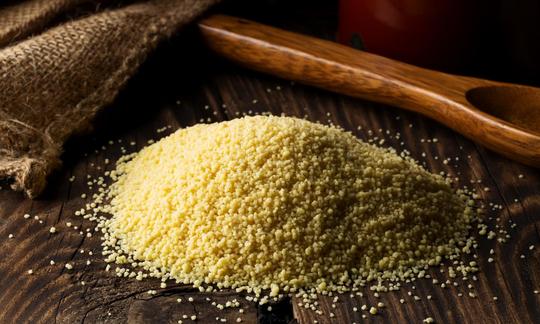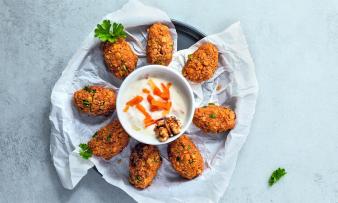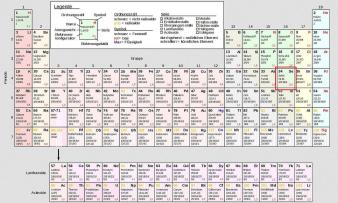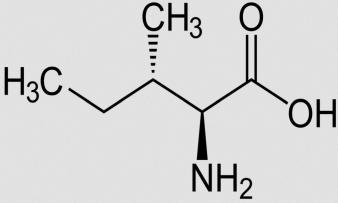Table of contents
Couscous is also spelled Cous Cous ( Cous-Cous) or Kuskus. It is actually a dish and not the special semolina that is usually sold as a product. This typical preparation of semolina that has been ground into balls and cooked is known from French-North African cuisine - and people buy the pre-cooked and dried pre-product.
Using couscous in the kitchen:
Couscous are yellowish, spherical grains, similar to coarse semolina (not semolina), but couscous is not raw. The taste is different from semolina, because couscous tastes a bit nutty and spicy, even without any other spices. What kind of grain is couscous? Couscous can be made from durum wheat (more precisely durum wheat semolina), barley, millet, spelt, and occasionally from oats, rice or corn (more precisely corn semolina).
Traditionally, couscous is prepared in a couscousière made up of two pots placed one on top of the other (also called a couscoussier). Vegetables or other ingredients are cooked in the lower pot, and the moistened semolina is steamed in the upper pot. This prevents the couscous from sticking together and remains grainy. To get perfectly cooked couscous, you have to take it off the heat and loosen it up again and again during the steaming and swelling process. It is usually mixed with a little olive oil or butter, arranged on a large plate, vegetables (or meat) are added in large pieces, and a stock is served in a separate bowl. Alternatively, you can use other, healthier oils, such as linseed oil, or mix the couscous with vegetable margarine for a vegan version. Couscous also tastes good without oil, perhaps in a salad with avocados or nuts.
Vegan recipe for couscous salad with peach:
Ingredients (for 4 servings): 500 ml vegetable stock, 200 g couscous, 1 red bell pepper, 2 peaches, 1 bunch of mint, 1 clove of garlic, 1 lime (squeezed), 2 tbsp maple syrup, 3 tsp curry powder, 3 tbsp rapeseed oil (cold pressed), sea salt,black pepper (grated).
Preparation: Put the couscous in a large bowl and pour the hot vegetable stock over it, cover and leave to simmer. In the meantime, wash the peppers and peaches and dice them finely. Wash the mint, shake dry, peel and chop. Chop the peeled garlic and mix it with 1 teaspoon of salt (or less) and the remaining ingredients to make a creamy dressing. This works best with a food processor. Add the vegetables, herbs and dressing to the couscous, season with salt and freshly ground pepper and enjoy the couscous salad served in bowls.
Vegan recipe for oriental spiced couscous:
Ingredients (for 2 servings): 2 tablespoons oil (e.g. rapeseed oil), 1 yellow bell pepper, 1 eggplant, salt, 100 g couscous, boiling hot water, pitted dates, 1 tablespoon fresh mint (e.g. peppermint), black or colored pepper as needed.
Preparation: Mix the couscous with about 1/2 teaspoon of salt (or less) in a bowl and pour boiling water over it, cover and leave to swell for about 5 minutes. Meanwhile, slowly heat the oil in a pan and fry the vegetables for a few minutes, then add salt. Loosen the couscous with a fork and mix with the vegetables and dates. Season to taste with finely chopped mint, freshly ground pepper and a little salt if necessary.
Can you replace couscous with bulgur? In many dishes, couscous can be easily replaced with bulgur, but the preparation method is slightly different and definitely takes longer.
Vegan recipes with couscous can be found under the note: " Recipes that have the most of this ingredient ".
| Not only vegans or vegetarians should read this: Vegans often eat unhealthily. Avoidable nutritional errors. |
Shopping - where to buy couscous?
Couscous, pre-cooked and dried, is available at all well-known supermarket chains such as Coop, Migros, Denner, Volg, Spar, Aldi, Lidl, Rewe, Edeka, Hofer etc. Supermarkets sell instant couscous made from durum wheat semolina. Sometimes you can find couscous made from spelt, occasionally even in organic quality. You can get organically certified couscous in drugstores, health food stores, organic shops and organic supermarkets ( Denn's Biomarkt, Alnatura). Online you can also find organic couscous made from other types of grain such as millet, spelt or barley. Oriental shops or African shops also traditionally sell couscous in larger containers.
Buy raw couscous: You cannot buy raw couscous. If you make raw couscous, you need to soak it before eating it (but not cook it) - or you can avoid using grains.
Is couscous made from whole grain? If you buy whole grain couscous, the word "whole grain" should be questioned, as semolina cannot be a whole grain product either. During production, the shell and germ are removed. For the "whole grain version" this is added back in afterwards. However, part of the endosperm is left out. This is then referred to as enriched semolina. 1 The differences lie primarily in the B vitamins (including folate) and the iron content. 4 But depending on the product, other substances can also be enriched. Conventionally produced couscous can also be bleached with caustic soda, which is not permitted for organic couscous. 2
The couscous available in supermarkets is often industrially produced, pre-cooked and then dried again. This instant product is not raw and is ready to eat after swelling in hot water. It is sold as "specially pre-cooked semolina" with the intended use of couscous printed on it.
Making your own couscous:
In Africa, especially in North Africa, people still occasionally make the semolina used for couscous themselves. To make it, put medium-sized semolina in a large bowl (sometimes a little extra flour is needed). Sprinkle this mixture with a little salt water. Now "swirl" the semolina with your hands until lumps the size of drops form. It is important not to knead here. Rub these lumps between the palms of your hands to form 1-3 mm balls.
There is also a method where you press the semolina lumps through sieves of different thicknesses, first through a coarse sieve and then through a sieve with medium-sized holes. With the sieve with small holes, you only sort out the very small balls. The rest is moistened and ground again and the process is repeated as before until it is all used up. Dry semolina is added again and again so that the grains do not stick together too much. After the drying phase, couscous can be stored for a long time. 3 Or you can pre-cook the semolina in a couscousière for 10-15 minutes and then dry it on a cloth. Couscous needs 1-2 days to dry in the sun. Well dried, pre-cooked semolina also keeps for a long time and, conveniently, it only takes a short time to swell - but it is no longer raw! Couscous can also be colored orange with pumpkin (common in Tunisia) or yellow with saffron (common in Algeria).
Storage:
Stored couscous, like homemade couscous, should be stored in a dry, dark and cool place. Like bulgur or polenta, couscous is based on chopped or ground grain. The fat in the grain can spoil if it breaks and the product can take on a rancid taste. Pests can also get in when the packaging is opened, which is why we recommend checking the stock regularly. Homemade couscous in particular must be completely dry before it is put into a glass or plastic container. Otherwise, mold will form. Well packaged and dried, couscous will last for at least a year.
Couscous prepared as a meal will last between one and three days, depending on what other ingredients are in the dish. Always prepare couscous fresh if possible.
Ingredients - nutritional value - calories of couscous:
The ingredients and energy content can vary depending on the source product. In this case (couscous made from durum wheat), 100 g of couscous contains around 376 kcal. Carbohydrates make up the majority here at 77%, followed by 13% proteins and less than 1% fat. Couscous, like durum wheat semolina or soft wheat semolina, has a fiber content of 5 g/100g, even slightly more than wholegrain rice (brown rice). Polenta is usually not peeled and therefore has almost twice as much fiber (9.4 g/100g). However, there is a variant of a lighter, white polenta ("polenta bianca"), made from peeled corn kernels. 4
The protein composition of couscous is very good, as the proportion of essential amino acids is high. For example, tryptophan, isoleucine, phenylalanine, threonine, leucine and valine are well represented. 4 Strictly speaking, threonine and lysine are the only two truly essential amino acids, as they are irreversibly transaminated (see the ingredient okara).
Couscous contains 0.78 mg of manganese per 100 g, which is comparable to the content of wheat flour and basmati rice. This trace element is very important for the development of cartilage tissue and is found in large quantities in nuts and seeds, such as hemp seeds (7.6 mg/100g) or poppy seeds (6.7 mg/100g). 4
Phosphorus is also included at 170 mg/100g, similar values are found in cooked chickpeas or raw lentils. Wheat bran contains a particularly high amount of phosphorus at 1,013 mg/100g. Phosphorus is an essential macronutrient and very important for bones, teeth and cell membranes. However, we hardly suffer from a deficiency with today's diet. Even a natural, balanced and vegan diet covers the phosphorus requirement well. In addition, most ready-made products and drinks contain far too much phosphoric acid, so an oversupply is much more of a concern. 4
When it comes to vitamins, three B vitamins are best represented: niacin (vitamin B3) is contained at 3.5 mg, pantothenic acid (vitamin B5) at 1.2 mg and thiamine (vitamin B1) at 0.16 mg per 100 g of couscous. B vitamins are very important for energy metabolism. 4
Selenium is certainly worth mentioning here, but the selenium content in grains can vary greatly depending on where they are grown. European soils are significantly lower in selenium than American soils. In addition, spelt has more selenium than wheat, and whole grains (with shell and germ) have more selenium than shelled products. 5 In uncooked couscous, the selenium content can be around 66 µg/100g, and in cooked couscous around 27.5 µg. This means that the value of linseed (25 µg/100g) is very similar. 4 The daily requirement for selenium varies slightly and is between 30 and 70 µg. Brazil nuts have around 1,917 µg/100g of this essential trace element, which means that around 1-2 Brazil nuts cover the daily requirement well. If you consume more than 400 µg of selenium daily over a longer period of time, this excess supply can even poison the body. 6
You can find all the ingredients of couscous, how much you cover with your daily requirement and comparison values with other ingredients in our nutrient tables below the ingredient image.
Health aspects - effects:
The health value is assessed differently depending on the raw material (wheat, barley or millet). Since we are dealing with couscous made from durum wheat, which is usually hulled and used as an instant product, all we can say is: couscous definitely provides a change from frequently consumed pasta. If you prepare couscous as a light salad or warm in combination with various vegetables, it is definitely healthy. It is important to leave out the fats or oils that are often added and not to eat too much couscous either, as hulled grains cause blood sugar levels to rise quickly. If you take the GI (glycemic index) into account, you can clearly see that couscous, at 65, has a higher GI than, for example, soft-boiled spaghetti (GI: 55, al dente: 45). According to the table, the values between 50 and 70 are average and can therefore be assessed similarly, although couscous has a slightly higher blood sugar-raising effect. 7
Can you lose weight with couscous? Together with natural ingredients such as vegetables, fat from nuts, lots of fresh herbs and little (or no) salt, couscous can help you lose weight. However, we cannot say whether this ingredient helps you lose weight more or less than white rice, potatoes or another grain such as bulgur or quinoa. Because: your personal constitution, the combination with other products and the amount consumed are also very important. This makes it difficult to give clear answers to questions such as: Which is healthier, potatoes or couscous? Which is healthier, bulgur or couscous? Which is healthier, couscous or quinoa?
What is healthy about couscous? People with sensitive digestion generally tolerate couscous very well. This may be related to the manufacturing process of the product (heat treatment). The type of base grain also plays a role here and everyone has to find this out for themselves. Patients with irritable bowel syndrome often do not tolerate products made from durum wheat very well, but they do tolerate those made from oats, millet, rice or buckwheat. 8
Sufficient selenium can reduce the risk of developing cancers such as breast, lung, stomach or esophageal cancer. 9 As an anti-inflammatory and antioxidant in the body, selenium can also prevent heart disease if consumed in sufficient quantities. 10
Dangers - Intolerances - Side effects:
Does couscous contain gluten? If you are gluten intolerant or sensitive, you should avoid couscous. There is an exception for couscous made from millet: Make sure that it is a certified gluten-free product that also has a gluten-free symbol (a crossed-out ear of corn). Contamination can always occur during production or packaging.
In 2017, a study of couscous from Morocco found mycotoxins that exceeded the limits applicable in the EU and recommended by the WHO. 11 Mycotoxins are secondary metabolic products of molds such as Aspergillus flavus. They are formed during cultivation, due to unfavorable storage conditions, during transport or during processing. The limits for each mycotoxin vary. For example, according to Regulation 1881/2006, aflatoxin B1 in cereals and cereal products must not exceed the maximum level of 2 μg/kg; the sum of aflatoxins B1, B2, G 1 and G 2 is 4 μg/kg. 12 Aflatoxin B1 is very dangerous, as even low concentrations can have a carcinogenic effect. 13
Potential for confusion:
Potential for confusion with couscous exists, sometimes deliberately. Wikipedia English shows examples such as Attiéké, a dish made from grated cassava root that is well-known in West Africa and looks very similar to couscous. Or Berkoukes: These are much larger balls that are eaten more like pasta, but the manufacturing process and the starting product are similar. Brazilian couscous (cuscuz) is made from corn flour/corn semolina. Kouskousaki is the name given to a pasta in Greece (kuskus in Turkey) that is served with cheese and walnuts.
Raw foodists also call their couscous-like preparations curry couscous, for example: these do not contain semolina, but are made from cauliflower, for example. The dish that is advertised as raw couscous, which consists of cashews, cannot be called raw food either, because cashews are not raw.
General information about couscous:
The original use of couscous can be traced back to North Africa. Immigrants brought this dish via France to the supermarkets of many western countries. Due to Arab rule in Sicily in the Middle Ages, this dish is still popular there today. 3 In Israel, couscous has been served as a national dish since immigrants from Arab countries arrived in 1948.
In the beginning, only millet semolina was used to prepare couscous, only later did durum wheat, barley, spelt and other types of grain come into play.
Alternative names:
In addition to the spellings Couscous, Cous Cous (Cous-Cous) or Kuskus, the Arabic-to-German transliteration "Kuskusī" is common; in central Morocco the dish is called "Seksu". In English, the North African dish is also called couscous, but the translation of the Arabic term is "kuskus" or "kseksu".
Literature - Sources:
Bibliography - 13 Sources (Link to the evidence)
| 1. | Spielberger-muehle.de Getreidewissen Griess. |
| 2. | Umweltberatung.at Cous Cous - gedämpfter Getreidegriess. |
| 3. | Perry C. Couscous. In: Davidson A. The Oxford Companion to Food. 3. Auflage. Oxford University Press: New York. 2014. |
| 4. | USDA United States Department of Agriculture. |
| 5. | Raumberg-gumpenstein.at Selen in Dinkel. 2006 (zuletzt aktualisiert 2020). |
| 6. | Pham-Huy LA, He H, Pham-Huy C. Free radicals, antioxidants in disease and health. Int J Biomed Sci. 2008 Jun;4(2):89–96. |
| 7. | Diabetes-austria.com Glykämischer Index (pdf). |
| 8. | Ndr.de Therapie beim Reizdarmsyndrom (FODMAP-arme Ernährung). Empfehlungen erarbeitet in Koop. mit Ernährungstherapie-Team vom medicum Hamburg. 2019. |
| 9. | Cai X, Wang C, Yu W et al. Selenium exposure and cancer risk: an updated meta-analysis and meta-regression. Scientific Reports. 2016;6. |
| 10. | Flores-Mateo G, Navas-Acien A, Pastor-Barriuso R, Guallar E. Selenium and coronary heart disease: a meta-analysis. Am J Clin Nutr. 2006 Oct;84(4):762–73 |
| 11. | Zinedine A, Fernández-Franzón M et al. Multi-mycotoxin contamination of couscous semolina commercialized in Marocco. Food Chemistry. 2017;214. |
| 12. | Amtsblatt der Europäischen Union. Verordnung (EG) Nr. 1881/2006 der Kommission vom 19. Dezember 2006 zur Festsetzung der Höchstgehalte für bestimmte Kontaminanten in Lebensmitteln. |
| 13. | Degen GH. Mykotoxine in Lebensmitteln: Vorkommen, Bedeutung und gesundheitliches Risiko. Bundesgesundheitsblatt. 2017. 60:745-756. |









Comments